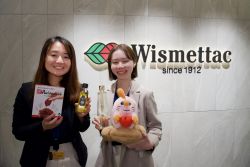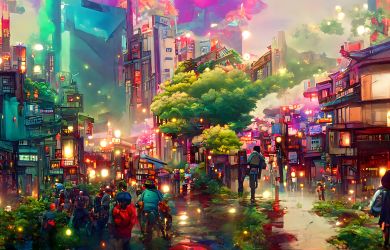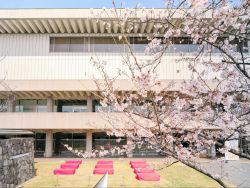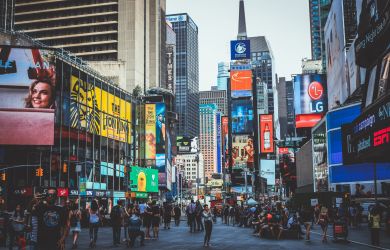![[Sub]urban Pleasures](https://metropolisjapan.com/wp-content/themes/metropolis/assets/images/no-image-large.png)
July 24, 2008
[Sub]urban Pleasures
Futako-Tamagawa offers attractions ranging from the spiritual to the cultural to the culinary. Here’s an insider’s guide TO THIS leafy Setagaya-ku neighborhood
By Metropolis
Originally published on metropolis.co.jp on July 2008

Illustration by Eparama Tuibenau
Futako-Tamagawa makes an underwhelming first impression. The Denentoshi line station, known colloquially as “Nikotama,” is surrounded by concrete and construction sites, and the most famous local landmark is a department store that opened the year man first stepped on the moon.
But as with so much of Tokyo, the best bits are tucked away in backstreets or buried in basements. Tokyo Walker, in fact, recently rated this little area of Setagaya Ward as one of the ten best places to live in the city. It’s also an area that’s about to undergo a ¥90 billion, 11.2-hectare facelift that will transform it from low-key riverside locale to major commercial hub with a new hotel, high-rise residence and multiple shopping complexes. So if you want to experience Nikotama before the hordes arrive, now’s the time.
Any day in Futako-Tamagawa should start with a caffeine injection at Café Fouquets. We hate to get superlative so early, but this elegant Euro-style café serves the best coffee in the area. The specialty drink here is dripped through handheld flannel filters, and if gastronomic snobbery makes you frown on drip-filtered coffee, these rich and aromatic blends should cure your prejudice. The most popular food at Café Fouquets is Belgian waffles, but if it’s too early for dessert, try a slice of the homemade quiche (available weekends): tall, fluffy and loaded with fresh veggies. Also on weekends, the cafe’s quaint terrace hosts live music—typically acoustic jazz or pop—under a tall zelkova tree. Perfect mellow weekendery.

Fukumitsuya (Photos by Daniel Machado)
When you’ve finished your coffee, head east for some culture. A ten-minute walk away is the Gotoh Museum, displaying the collection of Keita Gotoh, founder of Tokyu Rail. As you would expect from a rail magnate, Gotoh did plenty of traveling, and he amassed an impressive collection of premodern Oriental art, with an emphasis on Zen themes. Among the highlights are a Ming dynasty wine ewer and some of the original Heian-era scrolls illustrating The Tale of Genji (the scrolls, designated National Treasures, are displayed only for a week each May.)
Even if ancient pots and papers don’t excite you, you can stroll around the 15,000m2 gardens. These aren’t picture-postcard scenes, rather mazes of moss-covered pathways leading around Buddhist statues and small teahouses. For ¥60,000 you can rent one of the teahouses to entertain up to 50 guests.
Now, time for lunch. Head to the backstreets behind Takashimaya and look for the United Tribe surf shop. At the back of this narrow store is a surprisingly spacious kitchen that cooks up delightful macrobiotic bento lunches (¥950-¥1,050). Each morning chef Hitomi Katsuura updates her blog (www.yaplog.jp/u-t-natural) with details of the day’s menu, which might include tofu hamburgers, soy meat nuggets or marinated tempeh, always with brown rice and a selection of healthy side dishes. If it’s clement weather, grab a takeout box and head to the water. The wide, green banks of the Tama River offer plenty of space for picnics.
In the afternoon, make your way back past Takashimaya and follow our map into the residential side streets, where you should see a Buddha’s head poking out above the trees. The Gyokushin Mitsuin temple, better known as Tamagawa Daishi, was built in 1925 by Shingon sect Buddhists. For a local temple, it’s pleasant enough—but the building has an attraction that not even the city’s largest temples share.
Take off your shoes at the entrance, walk inside, and look to your left. You’ll notice a stairway in the corner leading down. Place ¥100 on the wooden tray, don the brown plastic slippers, and head down the steps. Almost immediately you’ll find yourself in absolute darkness with only the cold stone walls as your guide. As you shuffle slowly downward in the dark, your mind should fill with fear and doubt. But have no fear, because 5 meters below the temple you’ll emerge to an awe-inspiring sight: a snaking corridor of 300 candlelit statues of Kannon, goddess of mercy.
The whole 100-meter experience represents a walk through the innards of the sect’s revered Vairocana Buddha. Unless you win the lottery, this will be the most memorable ¥100 you’ll ever spend.

Gotoh Museum
A few blocks away from Tamagawa Daishi is Sanga no Yu (also known as Seta Onsen), Tokyo’s only mixed-sex hot spring. Better still, it’s Tokyo’s only outdoor hot spring with a bar attached. The proprietors claim that Mount Fuji is sometimes visible from one of the outdoor baths. If so, it would be a blip at the far end of some Setagaya-ku rooftops. But when you’re soaking in the 41°C curative waters sipping a beer or cocktail, sitting beside your special someone, you won’t care about the view. Be careful though: the mixed baths require swimwear.
After your soak, you can ride a free shuttle bus back to the station, but we recommend walking and making a stop at the Enoteca store on your left. This branch of the wine retail chain has a small bar at the back with surprisingly generous tasting sets. A single ¥500 coin will buy four glasses with liberal servings of selected wines. Even if you have no interest in buying a bottle, these samples are easily the cheapest way to enjoy good wine in Tamagawa. Oenophiles with deeper pockets can also sample vintage bottles by the glass at prices usually between ¥2,000-¥5,000.
If you prefer nihonshu, head for the basement of Takashimaya, where you’ll find sake shop Fukumitsuya, another alcohol retailer with a bar counter. Glasses vary in price from ¥300 to ¥1,000, and tasting sets, including a trio of seasonal recommendations and a selection of aged nihonshu, start at ¥1,200. The bar offers traditional snacks to accompany the sake, including pickled blowfish and miso-flavored tofu, as well as soft ice cream made from the sake lees. Fukumitsuya also serves soft drinks, but what would be the point of that?
If there’s still time, stroll around Takashimaya’s basement. Nikotama residents aren’t short of a yen or two, and this is where they come for their gourmet treats. There’s plenty of tasting on offer—in fact, it’s possible to enjoy a sample-sized multi-course meal, from soup through to desserts (and don’t miss the Meidi-ya and Leroy shops for free wine to wash it all down with). But save some room for dinner, because there are plenty of great dining options in the area.

Peace Tokyo
Peace Tokyo is the most picturesque restaurant in the summer months. From April each year, the Peace crew take over a makeshift structure on Tama river bank and turn it into a stylish eatery with numerous outdoor tables for truly verdant views. The menu won’t surprise or challenge—margarita pizzas, steak and fries, salads—but it’s all cooked superbly. Aside from having to use public loos to release your wine, this is one of the most enjoyable places to dine in Nikotama.
For washoku, try Tama no Ha Baiken, just behind Takashimaya. The specialty of the house is mamezara (¥1,480-¥2,180): trays containing five miniature dishes, as though a kaiseki meal came all at once. Options include a tofu set, with flavors such as tomato, sesame and pumpkin, and the chinme set, which includes shiokara and various dried fish. The drink menu focuses on umeshu, with 14 varieties, including green tea, brandy, yuzu and orange honey. We recommend the brown sugar umeshu from Kagoshima.
Other Nikotama culinary highlights include Miscelad’oro on the eighth floor of Takashimaya, which has a dual theme of premium Italian coffee and fine domestic cuisine. The meat and veggies are shipped in thrice-weekly from private farms in Nagano and all cooked to order. There’s also Giang’s, an unpretentious little Vietnamese eatery that Time Out Tokyo described as serving “the best home-style Vietnamese food in Tokyo and worth the train ride from Shibuya.”
For after-dinner drinks, Vanilla Beans is one of the area’s most popular evening hangouts. A snug basement bar next to the United Tribe surf store, it attracts a hip, young crowd and has a drink menu to suit all tastes, from cheap ‘n’ cheerful bottled beers to premium rums and tequilas (check the wall, rather than the printed menu, for the best stuff).

Vanilla Beans
By now you should have missed your train home, so cap the night off with a cocktail at Maruume. With a noren and sliding wooden door, this backstreet bar resembles a chic Japanese restaurant from the outside, and it only gets classier on the inside. The moody, blood-red lighting and hushed ambiance suggest that you’ll enjoy world-class drinks here—and pay heavily for them. The bartender, Takashi Makishima, is one of Tokyo’s great perfectionist drink mixers, fastidious about everything from the quality of the spirits to the type of ice he uses. And don’t be deterred by the decorous vibe: Maruume is as welcoming as any bar in the area.
Visitors to Futako-Tamagawa may not be struck by love at first sight, but this riverside locale offers a fantastic mix of gourmet dining, cultural treasures and lush scenery. Just get there before the developers raze all our recommendations.
Futako-Tamagawa station is nine minutes from Shibuya on the Denentoshi line and nine minutes
from Jiyugaoka on the Oimachi line.
In 1929 a group of restaurants in the Tamagawa area collaborated on an event that would lure customers and raise their profile. Eight decades later, the Tamagawa fireworks display is one of the largest pyrotechnic shows in the city, with 6,000 rockets launched from the banks of the Tama River. Competition is fierce for a decent view of the spectacle. The organizers are leasing some of the best spots at ¥5,000 per seat, or ¥12,000 for a four-person groundsheet, but you can also see the show from the smaller rotenburo of Seta Onsen as long as you get there early enough to nab a space in the tiny tub. This year’s firework display takes place August 16 from 7pm.
Café Fouquets 1F Tamagawa Takashimaya S·C, 3-17-1 Tamagawa, Setagaya-ku. Tel: 03-3708-5038. Open daily 10am-10pm (LO 9:30pm).
Enoteca Keyaki Court, 2-27-8 Tamagawa, Setagaya-ku. Tel: 03-5717-3334. Open daily 10am-9pm.
Giang’s 3F Kurokawa Bldg, 3-5-7 Tamagawa, Setagaya-ku. Tel: 03-3700-2475. Open Tue-Sun 5-10pm, closed Mon. www.giangs.com
Gotoh Museum 3-9-25 Kaminoge, Setagaya-ku. Tel: 03-5777-8600. Open Tue-Sun 10am-5pm, closed Mon. Admission: museum & garden: ¥700; garden only: ¥100. www.gotoh-museum.or.jp
Gyokushin Mitsuin temple (Tamagawa Daishi) 4-13-3 Seta, Setagaya-ku. Open daily 9am-5pm. Tel: 03-3700-2561.
Maruume 3-11-4 Tamagawa, Setagaya-ku. Tel: 03-5716-9981. Open Mon-Sat 7pm-3am, Sun & hols 7pm-midnight. http://maruume.1755.net
Miscelad’oro 8F Tamagawa Takashimaya S·C, 3-17-1 Tamagawa, Setagaya-ku. Tel: 03-3700-8834. Open daily 11am-11pm (LO 10pm). www.misceladoro.co.jp
Peace Tokyo 3-2-1 Tamagawa, Setagaya-ku. Tel: 03-3709-0220. Open daily 11:30am-10:30pm. (LO 9:30 pm). www.peacetokyo.com
Fukumitsuya B1 Tamagawa Takashimaya S·C, 3-17-1 Tamagawa, Setagaya-ku. Open daily 10am-9pm. (LO 8:30pm). Tel: 03-5717-3305. www.fukumitsuya.com
Sanga no Yu 4-15-30 Seta, Setagaya-ku. Tel: 03-3707-8228. Open daily 10am-11pm (last entry 10pm). Admission: adults ¥2,300, junior high school and below ¥1,700. www.setaonsen.co.jp/english
Tama no Ha Baiken 3-13-8 Tamagawa, Setagaya-ku. Tel: 03-3708-4832. Open daily 5-11pm (LO 10pm).
United Tribe 3-23-4 Tamagawa, Setagaya-ku. Tel: 03-5491-7514. Open Fri-Wed 11:30am-8pm, closed Thu. www.u-t-f.jp
Vanilla Beans 3-23-24 Tamagawa, Setagaya-ku. Tel: 03-3708-6773. Open Mon-Sat 6:30pm-3am, Sun 6:30pm-midnight. www.gotovanilla.com



イメージ(俯瞰)_Deck-Nicknamed-T-DeckOverlooking-view-image-1-390x250.jpg)



